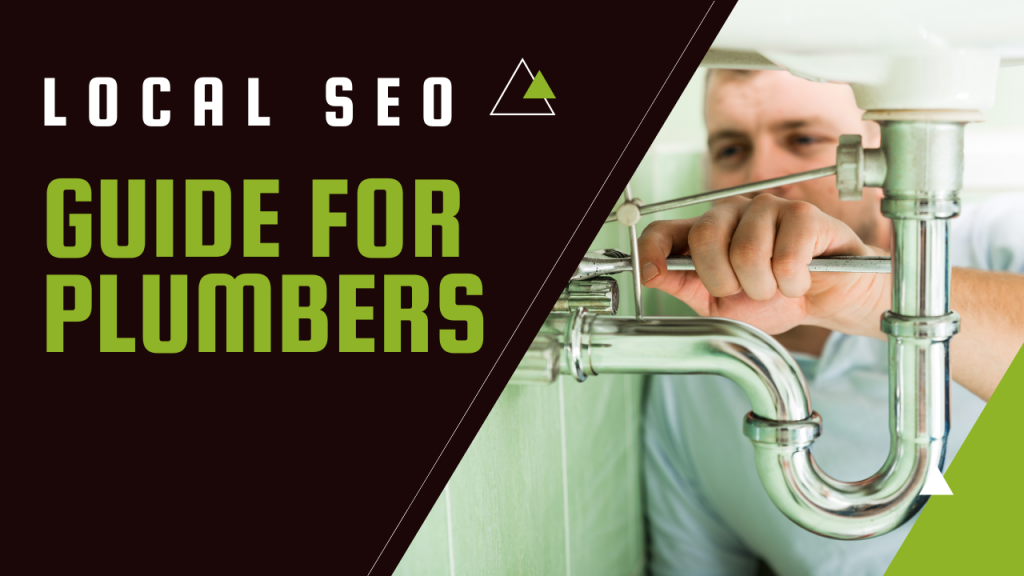When it comes to getting your company in front of potential customers when they are in need of a plumbing service, the plumbing industry is incredibly competitive, especially when you are competing with other plumbing companies. Especially nowadays, people who find themselves in need of a plumber immediately are used to making their first call to the top listing on Google and then working their way down from there. To beat your competition, check out our local SEO guide for plumbers.
What can you do to make sure that your business occupies the top listing when local homeowners or business owners are searching for a plumber that can attend to their needs as soon as possible?
It is very important to invest in local SEO services for your plumbing business if you are serious about becoming a top-ranking business on Google’s local search results. However, let’s take a look at why local SEO is worth it for plumbers and is a necessity in order for you to effectively advertise your plumbing services.
What Plumbing Companies Need to Know About Local SEO
1. The End of Yellow Pages
The yellow pages books are quickly becoming an anachronism. Today, the distribution of these bulky and heavy books is almost nonexistent as local searches are more frequently carried out through the web. While online searches and directory listings have little in common, there is one significant difference; you must be listed if you want customers to find you.
Approximately 46% of all searches on Google are local in nature.
As a matter of fact, they represent billions of searches for local information, local businesses, and local services. The person searching for local intent products/services is usually more motivated to make a purchase, which in turn increases the conversion rate.
Did you know that on average, 88% of those who conduct a local search on their smartphone decide to visit or call a store within one day? Since the last few years, local search has increased in popularity dramatically. The greater a person’s chances of finding your business on their mobile device, the more likely they are to stop in and check it out in person.
2. Recurring Free Traffic
The high rankings that are the result of a successful local SEO campaign will drive customers and clients to your website at no cost to them. Getting hired doesn’t cost anything either, as well. Free traffic and conversions make local SEO one of the most cost-effective methods of advertising and marketing.
3: Quick Results
If you run a local SEO campaign for your plumbing business, you’re only competing against other plumbing businesses within your geographic area. Little to no competition means that your business is more likely to rank higher in local search rankings. Second, it is also advantageous to have more local plumbers because many plumbing companies either ignore or put a minimal amount of effort into optimizing for local searches. Due to these factors, you can expect your business to get first page visibility on search engines for at least 30 days if you run a comprehensive SEO campaign.
The importance of local SEO cannot be understated. Below I have listed 5 steps you can take to build a campaign that can give your business the best chance of being seen in local searches and putting your services in front of customers at the precise point in time they are looking for a plumber.
Step 1. Keyword Research
There are a variety of keywords that can be used to draw more business to your company, but those that are especially relevant for your company’s plumbing services are the ones we recommend. The keywords of your available services might include the following: “emergency plumbing,” “clogged drain,” and “water heater repair.”
Once you have prepared a list of relevant keywords for your business, make sure that you create a Google AdWords account.
If you wish to take advantage of the free tools available as part of Google’s Ads platform you will need to register as a Google Ads account, but it won’t obligate you to pay for any advertising. It is a straightforward tool for entering your target search terms into and it will provide additional ideas as to what keywords you should target, as well as data on how much traffic those keywords generate.
Step 2. Keyword Optimization
You should optimize your Google My Business page and your website’s pages to introduce your business to prospective customers who are seeking the services you provide. It is important to optimize your home page and services pages first, which are also called the “core pages.” Once you have optimized your core pages, you can then move on to your content pages, such as a blog, an “About” page, and an FAQ section.
How to Optimize Your Google My Business Page
You have probably seen Google My Business pages when searching for restaurants, stores, and other service providers in your area, even if you have not set one up for your plumbing business. The “Maps” result is one of the key Google My Business features, as it is displayed to people when they search for specific types of local businesses.
One of the first goals of optimizing your Google My Business page will be to be found in the Maps section when people search for plumbing services in your area. It is important to create a second location for people to find your business online. Your plumbing website is already a first step, but optimizing your Google My Business page will also increase your company’s visibility on Google Maps – In most cases, this is achieved in as little as 30 days.
The steps to optimize your Google My Business page are as follows:
Claim and Verify Your Business
The first step in optimizing for Google My Business is to claim and then verify your website. To identify your business and claim your page, enter your business name, city and state into the Google search box. Google returns a template for your Google My Business page that includes basic information, such as your business name, address, and the button “Manage this page.” After clicking that button, you’ll be taken through a few steps to verify your business. Your business page can be optimized after you claim it and verify it.
You should provide the name of your company, its address and its phone number.
You should use the official version of your business name, address, and phone number on your Google My Business page, as well as on your website and other web pages. Other websites might include business directories, Facebook accounts, and the online version of the Yellow Pages. Staying consistent with this information produces three positive results:
- The map will accurately show your business location.
- The NAP of your business will be optimized when it appears consistently across the web.
- Customers will find your business easier
When you have a local phone number, it shows Google and your customers that you are a local business.
Categorization
Google allows you to list the services you provide but not the results of those services in the Categories section.
For example, you should include “Plumber” in your first category.
Be sure to include all relevant services in addition to Plumber.
This list may include:
- Plumbing Contractor
- Water Heater Repair Contractor
- Plumbing Repair
Your Business Description
It is important to describe your plumbing company’s services, duration in business, qualifications, benefits, and call to action in the description section. This section should include service details, contact information, and references. Include all hiring intent keywords for your plumbing services and specialties in your business description.
Here’s a formula for your Google My Business description: {Name of Business} offers professional {list plumbing services} in {Your City}. {Provide some background information about your business, and why customers should you.} Call {Phone Number} now – we’ll be there same day!
Keep your description relatively brief, about 100-200 words.
Hours of Operation
If you offer emergency services outside of your regular hours, list that information separately on your Google My Business page. Make sure all of your online business pages are consistent.
Relevant Images
The use of images on your Google My Business page will enhance your visibility and increase engagement, so take full advantage of this feature. Google allows multiple pictures to be displayed on your page, including the company logo, the exterior and interior of your business, and a photograph of you and your employees. Also, you can replace the basic background image of Google My Business with a photo of your business or your logo. Be sure to check out our guide on branding for plumbing companies.
How to Optimize Your Website
After optimizing your Google My Business page, you can proceed to optimize your website’s homepage and service pages. These are the pages on your website that will have the most impact on your search results.
Home Page
Optimizing your homepage starts with two elements that aren’t actually visible on the page. It’s important to make sure your plumbing website design is professional and contains key elements to help generate more leads.
Title Tag
Title tags, also known as page titles, appear immediately after the domain name of the website on the web browser, as well as listed as part of the headline when a page is listed on Google’s search results.
The title tag for your homepage should include your primary category, location, and business name. Here is a sample format: Plumber in {Your City} | {Business Name}. For example, if your plumbing business is in Atlanta GA and the name is “Purple Plumbing”, your title tag might be: Plumber in Atlanta GA | Purple Plumbing. Make sure your title tags are no more than 50-65 characters.
Meta Descriptions
Meta descriptions include information that inspires potential customers to click on the link and visit your website. Meta descriptions should be descriptive enough to encourage customers to click on the link and visit your site.
Here is a sample template for a meta description: {Business Name} provides professional {list of plumbing services} in {Your City}. Call {Phone Number} now and we’ll get a plumber out to you same day!
Here is what a meta description might look like for Purple Plumbing: Rapid Plumbing provides professional plumbing repair and water heater installation in Atlanta. Call 404-XXX-XXXX now and we’ll get a plumber out the same day! Meta descriptions can be any length, but Google generally truncates snippets to ~155–160 characters.
Header Tags – H1
The next step after optimizing the title tag and meta description is to optimize the content that your visitors will see on your home page. In your headline, also referred to as the “H1”, include the primary keyword for your business as part of the primary category. Here is a sample template: {Type of Service Provided} in {City, State}. Using this format, the headline might read: Plumbing Repair Services in Atlanta, GA.
Content
It is a good idea for your homepage to have at least 400 words with high quality content. Although, 500 to 1000 words will give you more SEO value. Make sure the content is written professionally, and it should not contain any misspellings or any grammatical errors; this should be quality content. Ensure you are providing informative and relevant content that will inform and engage your users, telling them about your services and encouraging them to dig deeper into the site.
There are several elements you need to include in your web page that are essential to the success of your company:
2) An expanded description of your company
2) Tell us about your professional background/qualifications.
3) Describe your services
4) You must mention your primary keyword at least once.
5) A call to action to encourage potential customers to contact you.
In addition to the above, there are additional optimization steps that you can perform on your homepage, but these should be your first priority.
Service Page Optimization
The creation of a separate page for each of the services you offer on your website allows for a great deal of focused information to be presented, which will lead to the best results in terms of SEO. Creating independent pages for each of your services will also be a much better choice than consolidating all your services onto one page. For example, if you provide drain cleaning, water heater maintenance, and plumbing repairs, you will be far better off creating separate pages for each service. Similar to the text on your homepage, the content on each service page should have between 500 and 1,000 words in length.
The SEO steps for each service page will be the same as those for the home page. However, it is vitally important to make sure the elements on each page are unique so as to get the best SEO results. Here are the elements that you should consider:
- Keywords related to services with commercial intent
- Title tags that specify the type of service
- The meta description provides information on the service.
- Description of the service in concise headers
- Each service is described in detail.
Building Content Pages
Content pages include everything on your site that is not your homepage or service pages, like a blog, an FAQ section or an “About” page. In contrast to the home/services pages on your site, content pages are primarily used for providing information rather than collecting data for conversion like core pages. Another difference is that content pages will feature keywords that signal research intent, as opposed to the commercial intent keywords that are used on core pages.
You’ll want to identify keywords that people use when searching for information related to your plumbing services in order to get the most out of your content pages. Researchers can find intent keywords that will drive traffic to your site using Google’s Keyword Planner Tool, using the same process as when they research commercial intent keywords for their core pages.
Ask yourself what questions people ask you about plumbing. If they ask you what causes a drain to clog, it’s likely that others are trying to figure that out as well. For instance, if the Planner Tool shows that people are searching for “things that clog a shower drain”, then you have a topic that you can write about in your content pages.
Where should information-based pages be hosted on your website?
When you create a Frequently Asked Questions (FAQ) section on your company’s website, you have the opportunity to share your expertise, build credibility, as well as introduce your business to people who may become customers when they run into a plumbing problem. In order to achieve the best SEO results, you will need to design a main page that lists your frequently asked questions and then link each question to its answer, which will reside on its own separate page.
In addition to FAQ pages, you can host information-based content on your website through a blog. A blog is a platform for showcasing your expertise, and posting new content regularly will boost your SEO campaign. It is our recommendation for a blog post to have 600 words at the very least, but feel free to write thousands of words if the subject calls for it.
Additionally, your content pages need to be optimized with unique title tags, meta descriptions, and headers, as well as well-written content that incorporates your research intent keywords.
Step 3. Getting Citations and Building Links
After you have optimized your website and Google My Business page (at least for now), it’s time to take the next step and begin to climb the local search rankings. In this step, you need to start link and citation building for your business.
Creating Citations
Citations can be defined as listing of the business’ Name, Address and Phone number (NAP) on another website. Be sure that the NAP on your site matches the NAP listed on your Google My Business page and that all URLs within your website pertain to your business. Next, verify that the NAP on your website matches the NAP listed on your Google My Business page.
The NAP should be consistent across your website and your local page, so you should begin applying for listings within a variety of directories once you’ve confirmed that your NAP is consistent. There are three general categories of directories:
1. The National and General Business Directory
Major general and national business directories include bizjournals.com, angieslist.com, and citysearch.com. You should also establish a business page on Facebook.
2. Plumbing Industry Directories
Several plumber-specific directories offer listings for free – we recommend focusing on these first. It is imperative that you set up Google Analytics to track your referral traffic and conversions from paid directories, if you are going for citations on those sites in order to ensure that they are cost-effective.
3. Local Directories
In addition to that, get your business listed in local directories in your area, such as your local Chamber of Commerce website which provides information about local businesses and your local newspaper which probably has an online version of a business directory as well.
4. Link Building
Search engines such as Google pay a lot of attention to links, or inbound links (also known as outbound links), that point to pages on your site originating from other websites. The level of importance of an inbound link in the search engine ranking algorithm is determined by where that inbound link originates. There are generally two types of external links that have a lot of weight for seo efforts: links from genuine sources, such as directories, but also links from authority websites, such as high profile business websites or sites within your industry.
What is the best way to get more links to your website?
Directories
Getting listed in directories is the same process as getting citations – just submit your NAPs to national, local and plumbing industry directories. You might be able to benefit from your SEO efforts and attracting new customers at the same time by getting listed in directories that include links on your website so that potential customers can easily find out more about you.
Relationships With People Offline
Most of your friends, colleagues, and associates probably have a website too. Take the time to see whether a mutually beneficial relationship can be established where websites can be integrated into one another for referrals. You can also take advantage of link building opportunities provided by your membership in associations, sponsorships of local events, or participation in charities.
Find out who is linking to your competitors
In fact, you can discover the websites that are linking to your competitors using a tool such as the Moz Link Explorer and then see if you can get the same kinds of links for your web pages. You will be able to use these insights in order to expand your linking profiles with new directories and to find out how to build links with additional authority and plumbing related sites.
However, even though there are more strategies for link-building, these tips can get you started on building an inbound link portfolio that will last.
Step 4. You Need To Get Some Reviews For Your Business
Many customers tend to trust reviews from third parties more than what a company says about itself. As a result, getting positive reviews is an important factor in attracting new customers as well as improve your SEO.
Make Sure You Focus On Google My Business Reviews.
Since many of your potential customers will see your Google My Business page before they are able to find any other information about your business, it makes sense if you can gather reviews on the page first. Having positive reviews on your Google My Business page will help in two different ways; it will rise in the search results for your business location and can serve as powerful persuasion as to why you are the number one plumber in the area.
Great Reviews: How to Get Them
It is very important to first and foremost provide great service in order for your business to get great reviews from your clients. Once your business has delivered a great service experience, you should invite your current clients to leave reviews. If you want to make getting great reviews as easy as possible, send an email with the subject line “review request” with a link to the review section on your Google My Business page.
To get that link, you will need to enter the name of your business followed by the search phrase “Google My Business.” Your Google My Business page will appear at the top of the search results. It is best to copy the URL that is listed in the search results of the profile search and add it to every email request for customers’ reviews. The email will direct the recipient to the review request form and instruct them to click “Write a Review” button.
For this kind of email, here’s some sample wording that you can use: “We recently provided plumbing services to your residence in Main St. If you have a moment, we would be grateful for your feedback about our work.”
It seems a great deal of our customers find us on Google – perhaps you did too. Would you please take five minutes to write a review on Google? Simply click here – Link to Google My Business profile and click on “Write a review.” Thanks in advance!”
It is our recommendation that our clients make it a habit to send request-for-review emails to all their happy customers to solicit their feedback. Thus, a steady stream of positive reviews will be posted on their Google My Business pages, resulting in a growing number of customers as well as better rankings in local search results.
Step 5. Tracking your Results
The most important steps that should be taken once the initial SEO work is complete is to stay on top of your results, so you can continuously improve the performance of your campaign. There are three most important metrics that you should monitor.
Track Rankings
When tracking your page rankings, you can gain insight into several aspects of your campaign, including keyword performance, impressions, and the number of people who clicked through to your site. The best way to track the page ranking of your website is for your webmaster to set up the Google Search Console on your website, formerly known as Google Webmaster Tools. The tool can be used once or twice per month to check the page ranking.
Track Traffic
The next thing that you need to do is to make sure that you are tracking the traffic that is being directed to your site and the pages on your site that it is guiding to. In addition to tracking where the traffic is coming from, you should also consider where it is going.
Installing Google Analytics on every page of your website is the best way to track your traffic and this platform should be installed on each page of your website. Although the process is straightforward, you might prefer that your webmaster does the work, especially if your site is large.
As a result, it is recommended that you review your traffic metrics on a monthly basis to determine long-term trends, determine how your SEO traffic is increasing, and find out where there are room for improvement.
Conversions
The conversion process is defined as the specific actions you would like prospective customers to perform while they are on your website. It is common for plumbers to convert phone calls into service calls, so you will definitely want to keep track of the number of phone calls that you receive, and how many of them translate into service calls. You can track phone calls through Google Analytics and conversions through Google Analytics. This will help you figure out the services that are bringing in the most clients, and also which pages have the highest conversion ratios and lowest.
Interested in getting started?
If you have a plumbing business, your commitment to developing a solid local SEO strategy will pay off handsomely in the form of more customers. The key is to commit to each step of the process until the end before moving on.
For a quick recap, the 5 steps to building a successful plumber SEO campaign are:
- Keyword research – Determining the keywords that are best suited for both commercial and research purposes
- Keyword optimization – both on and off your website
- Citations and Links – Extending your web presence and reaching new audiences
- Positive reviews – Make it a habit to get positive reviews
- Tracking – Focus on what’s working and improve areas that aren’t.
If you follow these steps, then you will be well on your way to building a local SEO campaign that will get your advertising campaign off to a solid start that will ensure higher rankings for your web page, more traffic to your website and more customers for your plumbing business.
Need help with Our Local SEO Guide for Plumbers?
If you’re interested in having us help with your local SEO campaigns, our plumber marketing agency specializes in helping plumbers get found on Google when people are searching for services in their local area. If you’d like a free SEO quote, contact us for more information.






